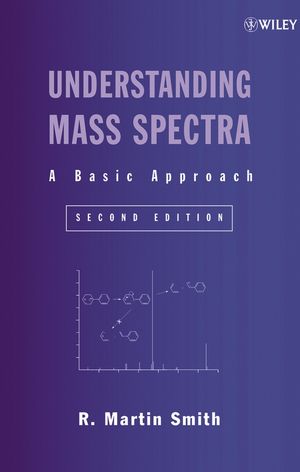Understanding Mass Spectra: A Basic Approach, 2nd EditionISBN: 978-0-471-42949-4
Hardcover
392 pages
September 2004
 This is a Print-on-Demand title. It will be printed specifically to fill your order. Please allow an additional 15-20 days delivery time. The book is not returnable.
|
||||||
Preface to the Second Edition xi
Acknowledgments xv
Abbreviations and Notations Used in This Book xvii
1 Instrumentation 1
1.1. Introduction 1
1.1.1. Overview 1
1.1.2. Sample Introduction 3
1.2. Ionization Source 4
1.2.1. Electron Ionization Source 5
1.2.2. Chemical Ionization 8
1.2.3. Other Ionization Methods 9
1.2.3.1. Electrospray Ionization 9
1.2.3.2. Desorption Ionization 12
1.3. mz Analysis 13
1.3.1. Time-of-Flight (TOF) 13
1.3.2. Magnetic Sector 15
1.3.3. Transmission Quadrupole 17
1.3.3.1. Selected Ion Monitoring (SIM) 21
1.3.4. Quadrupole Ion Trap (QIT) 22
1.3.5. Other Types of Mass Analysis 24
1.3.5.1. Mass Spectrometry Mass Spectrometry(MSMS) 24
1.3.5.2. Accurate m=z Analysis 26
1.3.6. Spectral Skewing 26
1.4. Ion Detection 30
1.4.1. Electron Multiplier 32
1.4.2. Photomultiplier Detector 33
1.5. Data System 33
1.5.1. Instrument Tuning and Calibration 33
1.5.2. The Mass Spectrum 37
1.5.2.1. Production of the Mass Spectrum 37
1.5.2.2. Terminology: Ions vs. Peaks 41
1.5.3. Library Searches 41
1.5.4. Using the Data System to Analyze GCMS Data 45
1.6. Criteria for Good-Quality Spectra 50
Additional Problems 51
Mass Spectrometric Resources on the Internet 52
References and Suggested Reading 53
2 Elemental Composition from Peak Intensities 56
2.1. Natural Isotopic Abundances 56
2.1.1. Atomic and Molecular Mass 59
2.1.2. Calculated Exact Masses and Mass Defects 60
2.2. Determining Elemental Composition from Isotope Peak Intensities 64
2.2.1. One or More Atoms of a Single Element 64
2.2.1.1. Chlorine and Bromine 64
2.2.1.2. Ion Designation and Nomenclature 70
2.2.1.3. Probability Considerations with Multiple Numbers of Atoms 71
2.2.1.4. Isotope Peak Intensity Ratios for Carbon-Containing Ions—The X þ 1 Peak 74
2.2.1.5. A, A þ 1, and A þ 2 Elements 77
2.2.1.6. Isotope Peak Intensity Ratios for Carbon-Containing Ions—The X þ 2 Peak 78
2.2.1.7. Overlapping Peak Clusters—Contributions from 13C Only 80
2.2.1.8. Silicon 82
2.2.2. Complex Isotope Clusters 83
2.2.2.1. Sulfur Dioxide 83
2.2.2.2. Diazepam 86
2.3. Obtaining Elemental Compositions from Isotope Peak Intensities 89
Examples 91
Additional Problems 96
References 98
3 Ionization, Fragmentation, and Electron Accounting 99
3.1. A Brief Review of Orbitals and Bonding 99
3.2. Even- and Odd-Electron Species 101
3.3. Site of Initial Ionization 103
3.4. Types of Fragmentation 107
3.5. The Nitrogen Rule 109
3.6. Energy Considerations in Fragmentation Processes 110
3.6.1. Fragmentation Rates 110
3.6.2. Metastable Ions 112
3.6.3. Energy Diagrams 113
3.6.4. Stevenson’s Rule 116
Additional Examples 117
Problems 119
References 120
4 Neutral Losses and Ion Series 121
4.1. Neutral Losses 121
4.1.1. Losses from the Molecular Ion 121
4.1.2. Loss of Small Molecules from Aromatic Ions 126
4.2. Low-Mass Ion Series 131
4.2.1. n-Alkane Spectra 132
4.2.2. Effect of Chain Branching on the Spectra of Aliphatic Hydrocarbons 134
4.2.3. Ion Series for Nonaromatic Compounds 136
4.2.4. Aromatic Ion Series 142
4.2.5. Use of Ion Series: Mass Chromatograms 145
Additional Problems 148
References 148
5 A Rational Approach to Mass Spectral Problem Solving 150
5.1. Guidelines for Solving Mass Spectral Problems 150
Examples 153
Problems 161
Reference 163
6 a-Cleavage and Related Fragmentations 164
6.1. Introduction 164
6.2. Benzylic Cleavage 166
6.3. Cleavage Next to Aliphatic Nitrogen 170
6.3.1. Structural Relationships: a-Cleavage in 1-Phenyl-2-aminopropanes 171
6.3.2. Cleavage Next to Electron-Deficient Nitrogen 176
6.3.3. a-Cleavage in Complex Nitrogenous Ring Systems 179
6.4. Cleavages of Aliphatic Oxygenated Compounds 180
6.4.1. a-Cleavage 180
6.4.2. Bond Cleavage Away from the Ionization Site 184
6.4.3. Cleavage at Carbonyl Groups 186
6.5. Elimination Fragmentations in Oxygen and Nitrogen Compounds 192
6.5.1. Secondary Elimination from Initial a-Cleavage Ions 192
6.5.2. Hydride Shifts 195
6.5.3. Elimination Fragmentations of Some Aromatic Compounds 196
6.5.4. Water Elimination in Aliphatic Alcohols 198
Examples 200
Additional Problems 202
References 206
7 Important Mass Spectral Rearrangements 207
7.1. Introduction 207
7.2. g-Hydrogen Rearrangement 208
7.2.1. McLafferty-Type Rearrangement 208
7.2.2. g-Hydrogen Rearrangement in Alkylbenzenes 213
7.2.3. g-Hydrogen Rearrangement Initiated by a Remote Ionization Site 217
7.3. Cyclohexanone-Type Rearrangement 223
7.4. Retro Diels–Alder Fragmentation 228
7.5. Double-Hydrogen (McLafferty þ 1) Rearrangement 234
Additional Problems 236
References 237
8 Rationalizing Mass Spectral Fragmentations 238
8.1. General Guidelines 238
8.2. Loss of Small Molecules 241
8.2.1. Loss of Small Molecules from Aromatic Ions Revisited 241
8.2.2. g-Butyrolactone 243
8.3. Ephedrine 246
8.4. Ortho Effect: The Hydroxybenzoic Acids 251
Additional Problems 254
References 256
9 Structure Determination in Complex Molecules Using Mass Spectrometry 257
9.1. Introduction 257
9.2. ‘‘Designer Drugs’’ Related to MDA 258
9.3. Cocaine and Its Metabolites 262
9.3.1. Peak Correlations 263
9.3.2. Proposed Fragmentations 268
9.3.3. Application 271
9.4. Phencyclidine and Its Analogs 274
9.4.1. Fragmentations of Phencyclidine 274
9.4.2. Phencyclidine Analogs 282
9.5. A Practical Problem 284
References 285
10 Answers to Problems 287
Index 353



